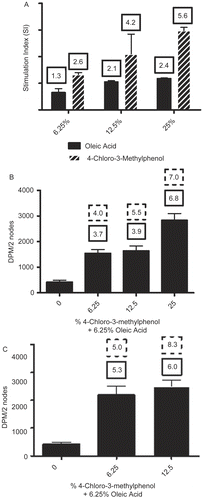Figures & data
Table 1. Irritancy and lymphocyte proliferation of MWFs.
Figure 1. (A) The HPLC-UV-ELSD analysis of Trim VX. Analysis of TRIM VX using ELSD detection (lower chromatogram) UV adsorption detection (upper chromatogram). The major components were (1) triethanolamine, (2) 4-chloro-3-methylphenol, (3) hexadecanoic acids, (4, 5, 6, 7) octadecanoic acids, (8, 9, 10) the methyl esters of hexadecanoic acids and octadecanoic acids, (11, 12, 13, 14) chloroparaffins, and (15) mineral oil. (B) Semi-preparative fractionation chromatograms of TRIM VX. Presented in this chromatogram are internal standards (bottom chromatogram), metalworking fluid sample plus internal standards (middle chromatogram), and the sample concentrated by multiple injections and separated into 10 fractions, F1 to F10 (top chromatogram).

Figure 2. TRIM VX analysis using GC-MS. Analysis of TRIM VX components using classical electron impact (EI) ionization mode is presented in the top chromatogram, positive chemical ionization in the middle chromatogram, and negative chemical ionization in the bottom chromatogram. The major components are identified by number: (1)(+)-a-terpineol, (2) 4-chloro-3-methylphenol, tripropylene glycol, and tripropylene glycol methyl ether, (3) triethanolamine borate, (4) hexadecanoic acid methyl ester, (5) 8-octadecenioc acid methyl ester, (6) octadecanoic acid methyl ester (7) 9-octadecenoic acid (oleic acid) (8) Bisphenol-A (IS) (9) dodecylbenzene (IS), (10) chloroparaffins, and (11) mineral oil.

Table 2. Identification and SAR evaluation of skin sensitization activity of TRIM VX constituents.
Table 3. LLNA/Irritancy dose-response studies for TRIM VX components.
Figure 3. LLNA mixture studies for CMP and OA. Dose response curves for the lymphocyte proliferative response after exposure to CMP or OA (A) and mixtures of CMP and OA (B and C). The average SI value obtained from three LLNA experiments is reported for all studies. The numbers above the bars in the solid line box represent the actual SI value while the numbers in the dashed line box represent the predicted SI values.
